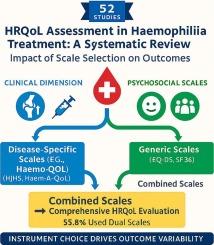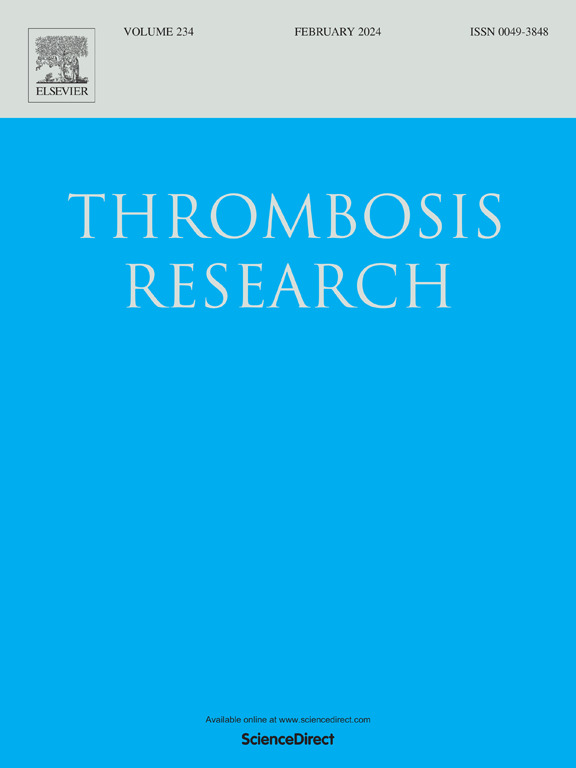血友病患者治疗后健康相关生活质量评估量表的有效性:系统评价
IF 3.4
3区 医学
Q1 HEMATOLOGY
引用次数: 0
摘要
血友病是一种遗传性出血性疾病,影响患者的身体、心理和社会福祉。虽然治疗的进步改善了临床结果,但用于评估其对健康相关生活质量(HRQoL)影响的工具差异很大。本研究评估血友病患者治疗后HRQoL评估量表的有效性和可变性,并确定影响患者QoL结果的因素。方法根据PRISMA指南,对截至2024年12月发表的研究进行系统评价。纳入的研究涉及血友病患者和治疗后报告的生活质量结果。使用Cochrane偏倚风险工具提取研究特征、患者人口统计学、干预措施和质量评估数据。综合研究结果,确定影响生活质量的关键主题。结果共纳入52项研究,涵盖预防性治疗、因子替代和基因治疗等治疗方法。大多数研究显示生活质量显著改善,特别是在严重病例中,年出血率(ABR)降低高达99%,关节健康得到改善。HRQoL工具的选择严重影响了结果的可变性,55.8%的研究使用了通用和疾病特异性量表的组合。疾病特异性量表(例如,Haemo-QOL)有效捕获血友病相关症状,而通用量表(例如,EQ-5D)测量更广泛的健康维度。然而,仪器应用的不一致性导致了报告的生活质量改善的差异。双量表方法提供了更全面的见解,尽管中度血友病的代表性不足。结论研究强调需要标准化、综合性的生活质量评估工具来准确评价血友病治疗。预防性治疗和延长半衰期因子浓缩物可显著改善患者的生活质量。未来的研究应侧重于标准化评估量表和整合心理社会维度,以充分捕捉治疗的影响。本文章由计算机程序翻译,如有差异,请以英文原文为准。

Effectiveness of health-related quality of life assessment scales in patients with haemophilia after treatment: Systematic review
Background
Haemophilia is a hereditary bleeding disorder that impacts patients' physical, psychological, and social well-being. While advancements in treatments have improved clinical outcomes, the tools used to assess their effect on health-related quality of life (HRQoL) vary widely. This study evaluates the effectiveness and variability of HRQoL assessment scales in haemophilia patients after treatment and identifies factors influencing QoL outcomes.
Methods
A systematic review, adhering to PRISMA guidelines, was conducted on studies published up to December 2024. Included studies involved haemophilia patients and reported QoL outcomes post-treatment. Data were extracted on study characteristics, patient demographics, interventions, and quality assessment using the Cochrane Risk of Bias Tool. Findings were synthesised to identify key themes affecting QoL.
Results
The review included 52 studies, covering treatments such as prophylactic therapies, factor replacement, and gene therapy. Most studies showed significant QoL improvements, particularly in severe cases, with reductions in annual bleed rates (ABR) up to 99 % and improved joint health. Outcome variability was heavily influenced by the choice of HRQoL instruments, with 55.8 % of studies using a combination of generic and disease-specific scales. Disease-specific scales (e.g., Haemo-QOL) effectively captured haemophilia-related symptoms, while generic scales (e.g., EQ-5D) measured broader health dimensions. However, inconsistencies in instrument application contributed to disparities in reported QoL improvements. Dual-scale approaches provided more comprehensive insights, though moderate haemophilia was underrepresented.
Conclusions
The study emphasises the need for standardised and comprehensive QoL assessment tools to evaluate haemophilia treatments accurately. Prophylactic therapies and extended half-life factor concentrates showed significant QoL improvements. Future research should focus on standardising assessment scales and integrating psychosocial dimensions to fully capture treatment impacts.
求助全文
通过发布文献求助,成功后即可免费获取论文全文。
去求助
来源期刊

Thrombosis research
医学-外周血管病
CiteScore
14.60
自引率
4.00%
发文量
364
审稿时长
31 days
期刊介绍:
Thrombosis Research is an international journal dedicated to the swift dissemination of new information on thrombosis, hemostasis, and vascular biology, aimed at advancing both science and clinical care. The journal publishes peer-reviewed original research, reviews, editorials, opinions, and critiques, covering both basic and clinical studies. Priority is given to research that promises novel approaches in the diagnosis, therapy, prognosis, and prevention of thrombotic and hemorrhagic diseases.
 求助内容:
求助内容: 应助结果提醒方式:
应助结果提醒方式:


